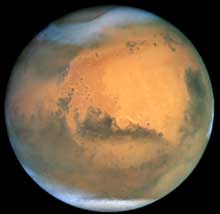Earth Sciences
Earth Sciences (also referred to as Geosciences), which deals with basic issues surrounding our planet, plays a vital role in the area of energy and raw materials supply.
Earth Sciences comprises subjects such as geology, geography, geological informatics, paleontology, mineralogy, petrography, crystallography, geophysics, geodesy, glaciology, cartography, photogrammetry, meteorology and seismology, early-warning systems, earthquake research and polar research.

Climate model for Earth also describes changes on Mars
Orbit affects climate on Mars similar to the way it affects climate on Earth, say three scientists, who used a model of climate change on Earth to explain the layers of deposits in the polar regions of the Red Planet.
Their study appears in the Sept. 26 issue of Nature, and suggests that a climate change theory for Earth can also be applied to Mars and possibly to other Earth-like planets.
“The orbital theory of climate change has been successful in explaining changes in the Earth&

Antarctic forecast: premature break-up of ozone hole this week
Based on satellite data from the European Space Agency, the national meteorological centre of the Netherlands predicts the Antarctic ozone hole will break apart this week, months earlier than usual.
A scientist at the Royal Netherlands Meteorological Institute (KNMI) adds that the depth of the ozone hole is much smaller than previously seen.
“This breakdown is occurring exceptionally early in the year, about two months earlier than normal”, says Henk Eskes, a KNMI senior scientist.

Researchers show why active mountains don’t get taller
Active mountain ranges like the Olympic Mountains, Taiwan Central Range or the Southern Alps are still growing, but they are not getting any taller. River cutting and erosion keep the heights and widths of uplifted mountain ranges in a steady state according to an international team of geoscientists.
“These mountains grew to 2.5 to 3 miles high over the past few million years and then they stopped increasing,” says Dr. Rudy L. Slingerland, professor of geology and head of Penn State’s g

50 years of climate change — and possible futures
A new study using a computer climate model to simulate the last 50 years of climate changes, projects warming over the next 50 years regardless of whether or not nations curb their greenhouse gas emissions soon. If no emission reductions are made and they continue to increase at the current rate, global temperatures may increase by 1-2 degrees Celsius [2-4 degrees Fahrenheit]. But if the growth rate of carbon dioxide does not exceed its current rate and if the growth of true air pollutants (substance

New study casts doubt on validity of standard earthquake-prediction model
A new study by Stanford University geophysicists is raising serious questions about a fundamental technique used to make long-range earthquake predictions.
Writing in the journal Nature, geophysicists Jessica Murray and Paul Segall show how a widely used earthquake model failed to predict when a long-anticipated magnitude 6 quake would strike the San Andreas Fault in Central California.
In their Sept. 19 Nature study, Murray and Segall analyzed the “time-predictable recurrence mod

ESA satellite imagery credited with breakthrough in earthquake research
California scientists credit synthetic aperture radar imagery from the European Space Agency with making possible new ways to depict earthquake fault zones and uncovering unusual earthquake-related deformations. Their study of imagery from a 1999 earthquake in the western US could provide a new way to identify active faults and help track when the last earthquake occurred on a fault zone.
Writing in last week’s issue of Science magazine, researchers from the Scripps Institution of Oceanograp